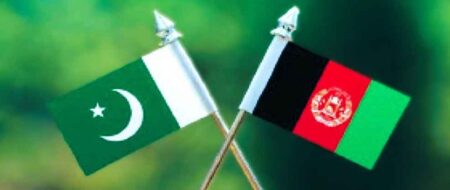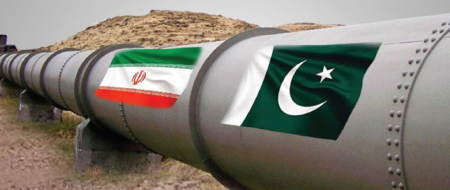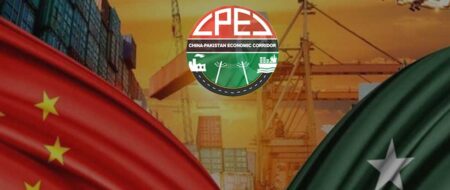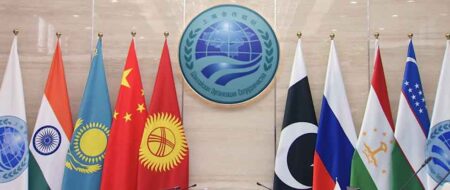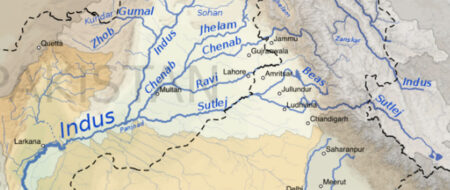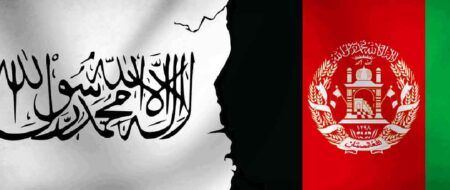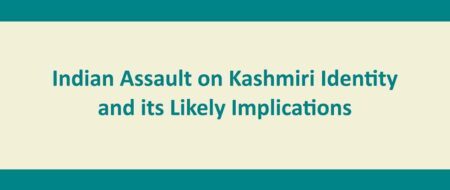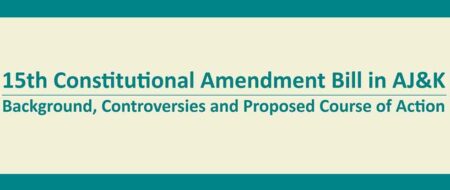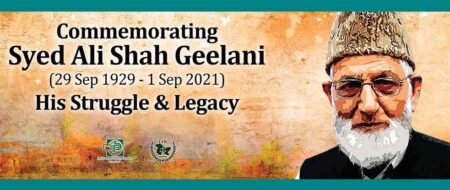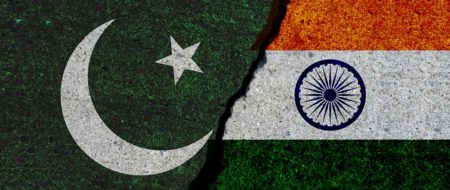Northern Areas of Pakistan-Facts, Problems and Recommendations
The Northern Areas (NAs) of Pakistan, where a million people reside, and where political, democratic, constitutional and administrative institutions are yet to take roots, also makes a case of intellectual vacuum. A cursory look at the existing literature will reveal that the available studies on NAs do provide valuable information regarding the history, societal conditions, wars between the local Rajas and tales of valour, and about the towering mountain peaks and glaciers. Similarly, enough material is available about the freedom movement of 1947. Then there are books on tourism in NAs, which contain vast and precious information.
Policy Perspectives, Vlm 1, No.1
The Northern Areas (NAs) of Pakistan, where a million people reside, and where political, democratic, constitutional and administrative institutions are yet to take roots, also makes a case of intellectual vacuum. A cursory look at the existing literature will reveal that the available studies on NAs do provide valuable information regarding the history, societal conditions, wars between the local Rajas and tales of valour, and about the towering mountain peaks and glaciers. Similarly, enough material is available about the freedom movement of 1947. Then there are books on tourism in NAs, which contain vast and precious information. Yet, there is general apathy towards the political, economic and social conditions prevalent in NAs since the last 50 years.
The national media also casts a similar picture. The hundreds of articles that appear in the newspapers generally lack objectivity even in discussing the historical position of Northern Areas and their relations with the state of Jammu and Kashmir. Obsessed with pre-determined positions, writers discuss the events and historic facts only in supporting their own stances. Barring exceptions one generally finds nothing new but a repetition of cases and arguments.
However, a positive development appeared after 1990 when the national press started anchoring correspondents in the Areas. Periodical diaries of these correspondents became a useful, direct and regular source of information flowing from the Northern Areas to other parts of the country.
May 1999 clash at Kargil focussed world attention on the NAs and it became subject of hot discussion also in the international media. Still quite naturally the focal point remained Pakistan-India relations and the issue of Kashmir. However, the constitutional problems and the constraints faced by the people could not become the subject of general discussion.
Seen in this background, the decision of the Supreme Court of Pakistan (28 May, 1999) about the status of the Northern Areas assumes great importance. The decision has provided clear guidance in constitutional, administrative and legal matters. Supreme Court through its verdict ordered the government of Pakistan to ensure provision of basic rights to the people of Northern Areas within six months. Owing to political instability
and uncertainty, no encouraging progress was however, made to implement the decision within the stipulated period or even later.
In this background this paper looks at the evolution of Northern Areas and its relations with the Islamabad as well as its ties with the Kashmir conflict. Likewise, paper examines the prevalent socio-economic and political situation and suggest some reforms to improve the conditions of the local people.
Northern Areas: Historical Facts
Before partition of the sub-Continent, the state of Jammu and Kashmir with a total area of 84471 square miles, was geographically divided into following three big regions:
Jammu Province (12,378 sq. miles)
- Kashmir Province (8,539 sq.)
- Frontier Province of Ladakh and Gilgit (63,554 sq)
In 1947, a part of the state gained independence and was called Azad Jammu and Kashmir, which has an area of 5,134 square miles. While 29,814 square miles chunk of the Frontier Province of Ladakh and Gilgit after winning freedom came under the administrative control of Pakistan through an agreement. This is the area now called Northern Areas. The rest of the Frontier province i.e. 3,3740 sq. miles area of Ladakh is under Indian occupation . The Northern Areas of Pakistan are source of global attraction for their heights and vast ranges of K-2, Hindukush, Pamir and the Himalayas.
Constitutional Position
- Historically these areas belong to Dogra State of Jammu and Kashmir. On March 29, 1935, the British government took possession of Gilgit Agency from the state government, through a lease agreement for 60 years. The British feared of the Soviet expansionist moves, and therefore wanted to have direct control in the region. During this period the state flag remained hoisted over residency along with the Union Jack. However by August 1, 1947, the areas were returned to the state government , because the British had decided partitioning of the Indian sub-continent.
- In the state elections held in 1934, 1937 and 1941, five representatives of these areas were taken in the Jammu & Kashmir assembly. Even in the last state assembly, which terminated in 1947, the areas were represented.
- Through a jointly formed armed struggle of the local people, the Gilgit Scouts and the Muslim officers of the Maharaja’s army, the area was liberated on November 1, 1947 and an interim government constituted under Raja Shah Rais Khan of Gilgit. The government of Pakistan was invited through a telegram to take control of the areas. Responding to this request Sardar Muhammad Alam (A tehsildar in the NWFP government at that time) was appointed and sent to Gilgit on 16th November, as government of Pakistan’s political agent.
- In April 1949 because of several administrative constraints an agreement was reached between the government of Pakistan and government of Azad Jammu and Kashmir (AJ & K). Accordingly the administrative control of Gilgit and Baltistan was temporarily transferred to the former. Vide sub-clause 8 of section-3 of this Agreement, the affairs of Gilgit and Baltistan were brought under the control of Political Agent appointed by the government of Pakistan.
- In the same year (1949), the United Nations stopped the war in Kashmir and established the Cease-fire Line. Through the Simla Agreement (1972), the same CFL was converted and renamed Line of Control (LoC) with some adjustments. That cease-fire (control) Line was also established in the Northern Areas. It was through that decision that the U.N. observers were posted on the control line and are still there between the Occupied Ladakh and Northern Areas.
- Map of the state of Jammu and Kashmir published by the Pakistan’s Ministry of Kashmir Affairs in February 1954 shows Gilgit and Baltistan both in terms of area and population, as part of the state of Jammu and Kashmir . Also the maps published by Survey of Pakistan continued to show the Northern Areas as part of AJ & K as late as up to 1987.
- The geographic details and explanation of the areas under Pakistan, as given in the constitutions of 1956, 1962 and 1973, do not cover Northern Areas as part of Pakistan. When Martial Law was imposed in 1958, it was not extended to Northern Areas, because according to the principle stand of Pakistan, these areas (still) did not belong to Pakistan [Their fate was yet to be decided].
Through the Sino-Pak border Agreement of March 2, 1963, certain areas were mutually transferred by adjustment. The agreement contained a clause (article 6) that after the Kashmir dispute was resolved, the government in power in Northern Areas and the Peoples Republic of China will re-negotiate the agreement. The agreement is called Sinkiang-Kashmir Border Agreement.
- India lodged protest against the Sino-Pak Agreement. Through its letter dated 16th March 1963, addressed to the President of the U.N. Security Council, India took the stand that the agreement was a violation of the resolutions of the Security Council and the U.N. Commission for India-Pakistan. Pakistan’s position was that Northern Areas were integrated part of the disputed state of Jammu and Kashmir, and their fate is yet to be decided along with the rest of the State, through a plebiscite as provided in the U.N. resolutions. Relevant text of the then Foreign Mister of Pakistan, Zulfiqar Ali Bhutto explaining the Pakistan’s position is reproduced as follows:
- My Government is bound by its duty to declare the Security Council that, pending determination of the future of Kashmir, through the will of the people impartially ascertained, no position taken or adjustments made by either of the parties to the present controversy between India and China or any similar controversy in the future shall be valid or affect the status of the territory of Jammu and Kashmir or the imperatives or demilitarization and self determination of the state of Jammu and Kashmir laid down in the resolution of 21 April 1948, 30 March 1951, 24 January 1957, and in resolutions of the United Nations Commissions for India and Pakistan, dated 13 August 1948, and 5 January 1949, which have been jointly accepted by both India and Pakistan and by which both governments, according to their repeated declarations, stand engaged.
“The Boundary Agreement (between Pakistan and China) does not affect the status of the territory of Jammu and Kashmir. It does not affect the imperatives of demilitarization of the state. It does not derogate one jot or title from the right of self-determination of the people.
When in the occupied Jammu and Kashmir, the “All Jammu and Kashmir Conference” recommended through a resolution (27 October, 1950), that the future shape and annexation of the state of Jammu and Kashmir be decided through the Constituent Assembly, the Security Council took the decision in its Resolution of 30 March, 1951 (accepted both by Pakistan and India) that such an assembly had no authority to decide the future of the state.
- During the hearing of the Indian plane (Ganga) hijacking case started in 1971 and ended on 17 May, 1973, the Attorney General of Pakistan admitted before the Supreme Court of Pakistan that: “No given part of the state of Jammu and Kashmir can decide on its own, to join either Pakistan or India”.
- While establishing the constitutional future of the Northern Areas, the full bench of the Azad Kashmir High Court (verdict on Gilgit and Baltistan (N.A.) March 18, 1993) held in a petition filed by Mohammad Miskeen and Haji Bashir Khan of Gilgit and Shaikh Abdul Aziz Advocate of Muzaffarabad:
- Northern Areas (Gilgit and Baltistan) are part of Azad Kashmir, historically and constitutionally;
- The Azad Kashmir government should establish administrative and legal institutions in these areas.
- Under the Provisional Constitutional Act, 1974, the (A.K.) High Court has the right to hear all petitions concerning Azad Kashmir;
- And (the Court) also has right to hear cases in all matters pertaining to Northern Areas.
- The government of AJ&K appealed against the decision of the High Court in the AJ&K Supreme Court, which announced its decision on 14 September, 1994, stating: “No doubt, that Northern Areas are part of the state of Jammu and Kashmir – but not of Azad Kashmir. Therefore, the government need not take administrative control of these areas.
- The Supreme Court of Pakistan ordered the government vide its decision of May 28, 1999, that Northern Areas were constitutional part of the state of Jammu and Kashmir. The government of Pakistan should ensure that basic human rights and other political and administrative institutions are provided in the areas within six months. However, the action should not adversely affect Pakistan’s stand concerning the Kashmir dispute.
The Indian Stand
- The Indian Constitution provides that the Northern Areas [of Pakistan] and Azad Kashmir are part of the Indian Union. That is why the Indian Occupied Kashmir Assembly has 25 seats reserved for Azad Kashmir, Gilgit and Baltistan, on the basis of 1941-51 census.
- The greater part of Northern Areas – adjacent to Ladakh and Kargil – is administered by India as part of its occupied Kashmir. Members for the Indian Occupied Kashmir assembly are also elected from Ladakh and Kargil. Even ministers are taken from there and the administrative control rests with the government of Occupied Kashmir. Seeing that Ladakh and Kargil are farther away from Srinagar as compared to the distance between Azad Kashmir and Northern Areas, the situation on Pakistan’s side assumes special importance. That India which has even declared the state of Jammu and Kashmir as its integral part treats Ladakh and Kargil as part of the state.
Post Independence Progress
No sooner did Sardar Muhammad Alam took over as Political Agent of Pakistan in November 1947, the Frontier Crimes Regulations (FCR) were enforced over whole of Northern Areas. This was the English law for the tribal areas through which a civil servant exercised all judicial and administrative powers. (It is worth noting that prior to this FCR, the Maharaja of Kashmir in his period had provided an independent judicial system for the areas, and the people could appeal before the Kashmir High Court). Furthermore, a feature of the new system was that the Political Agent was placed under the Political Resident of the NWFP.
In 1950, the federal Government brought the affairs of the Northern Areas under the administrative control of Ministry of Kashmir Affairs and Northern Areas, which remains as such since then. The ministry introduced the post of Political Resident instead of Political Agent. In 1952, a Joint Secretary of the Ministry of Kashmir Affairs was appointed Resident for the Northern Areas . However, no change occurred in essence with the new system, because the administrative and judicial authorities remained centralized, as in the past, in the position of the Resident and no system was designed for political representation. People of the area were not very happy with this state of affairs. Some of the significant responses and developments are as follows:
- Colonel Mirza Hasan Khan, the hero of the freedom war, established a party – the Gilgit League – in 1957. This was the first political organization set up at the local level. After the 1958 Martial Law, the organization got banned, and Mirza Hasan joined the Azad Kashmir civil service.
- During the sixties an organization was established named “Gilgit and Baltistan Jamhoori Mahaz” (Democratic Front). The Mahaz employed means like print media, literature and demonstrations to present with full force the case of political and constitutional rights of the people. It was due to the struggle of this organization that the AJ&K assembly adopted the resolution seeking Northern Areas joining of AJ&K. This organization also got inactive after 1973.
- In 1973, “Gilgit and Baltistan Students Federation” was organized in Karachi by the students of the area studying in Karachi. Although nothing happened in substance because of this movement, yet the organization played an important role in introducing the problems of the rights of Northern Areas’ people in a Metropolitan like Karachi. After 1976, however the Federation also became inactive and ceased all activities.
The Ministry of Kashmir Affairs introduced some reforms in 1967. Inter alia, a Resident was appointed instead of Political Resident with his headquarter in Gilgit. The tasks of administration, High Court and Revenue Commissioner were all pooled in the body of the Resident.
Under the Resident, there used to be two Political Agents, one each for Gilgit and Baltistan agencies. Each of the Political Agents exercised the following powers simultaneously in his jurisdiction:
The above list is well indicative of the powers and authority of the Resident and Political Agent.
- Elections in Northern Areas conducted for the first time in 1970. These were for the NA Advisory Council consisting of 16 members. It was the first representative body of the Northern Areas. While the Council had the power to sanction development schemes it was almost helpless in all other matters. During its early days, Commissioner N.A. (Resident) used to chair the Council. Later, a change was brought about, and the Federal Minister for Kashmir Affairs became the chairman.
- An incident occurred during this period brought a number of changes in the administrative set-up in NAs. The daughter of an officer of the Gilgit Scouts (the law and order agency under the local administration) could not pass a school examination. Her mother visited the school and had bitter exchanges with the Head mistress. The Head mistress complained to the Deputy Commissioner, who suspended her service. A delegation of Tanzeem-e-Millat went to see the Resident Commissioner to get redressed the injustice done to the Head mistress. The Commissioner insulted the delegation. To react, the organization took to the streets with protest rallies and meetings. In response, the administration resorted to firing killing a few demonstrators. This incident turned into a political movement demanding basic rights for the Northern Areas. Because of mishandling by the administration, the element of violence entered into an otherwise peaceful protest movement. The administration got hold of and imprisoned fifteen top leaders of the “Tanzeem”. But people broke the jail and set their leaders free.
- During 1972 the then government of Mr. Z. A. Bhutto announced a general amnesty with reference to the above incident. In a package reform it replaced FCR. and instituted a new district Diamir with immediate effect. The President of Pakistan, through his proclamation of August 1972, brought about fundamental structural reforms:
- The system of Feudal Lords, Rajas, Mir of Nagar and Agency was abolished;
- Gilgit and Baltistan agencies were given the status of districts;
- “Resident” and “Political Agent” were re-named Commissioner and Deputy Commissioner, respectively.
When on July 5, 1977 General Zia ul Haq imposed Martial Law in Pakistan, the Northern Areas were also declared “Martial Law Zone-E” (A to D being the four Provinces). From the administrative viewpoint, this was the first important decision that gave rise to confusion about the constitutional position of the Northern Areas. To this, the contradictory statements made by President Zia about the areas’ future and constitutional position added further confusion. In April 1982, the newspapers reported the President stating: that Gilgit, Skardu and Hunza were not “disputed” areas, but part of Pakistan34. Speaking to correspondents in Quetta on May 9, 1982, he said: “Kashmir has been a disputed issue, but so far as the Northern Areas are concerned, we do not accept them disputed. The President also nominated three individuals of the area, for the Majlis-e-Shura, as observers. Inaugurating the second session of the Shura, President Zia expressed his happiness that representatives from Northern Areas were there. He said “I am not talking of Kashmir; I am talking about the Northern Areas, which make part of Pakistan.”
With the said remarks of the President, the media naturally took up the issue. Various quarters objected the new stand. It was the period when four of the major political parties (Jammu and Kashmir Muslim Conference, Azad Kashmir People’s Party, Jammu and Kashmir Mahaz-e-Raiy Shumari, and Azad Muslim Conference) had joined in a movement for the restoration of democracy. Leaders of all the four parties sent a jointly signed letter to President Zia on May 4, 1982. The letter explained in sufficient detail the position of the areas: that they belonged to the state, and like the rest of the state constituents, their future position was yet to be decided. That the U.N. Documents provided ample proof and that it has been the principle stand of all past governments in Pakistan. The President’s statements were depriving around 6 to 7 hundred thousands inhabitants of the area of their right to vote in the plebiscite, which will be a great loss to Kashmir and to Pakistan.
Although the President did not reply the letter, but sometimes afterwards conceded in an interview with M.J. Akbar (Editor Weekly Sunday, India), that Gilgit and Baltistan were not part of Pakistan and were as much disputed as the rest of the Kashmir. With this the press discussion ended for the time being. However, while meeting a delegation of the Northern Areas on 15 April, 1985, President Zia-ul Haq again indicated, that: Northern Areas will be given representation before the next meeting of the National Assembly, and that elections for the National Assembly seats will be held in the three Northern Areas districts including Skardu and Gilgit. Also, that the Justice Ministry has been directed and it was considering to remove obstacles in the way of Northern Area’s representation in the National Assembly. After the case review, Northern Areas will be given representation in the National Assembly and the Senate through a notification. However, there was neither any notification made, nor the pronounced representation could be given in the Assembly and the Senate.
A high power Committee was constituted in 1984-85 to settle the future of the Northern Areas. Members of the Committee included the Secretaries of Divisions/ Ministries of Establishment, Finance, Planning, Law, Interior, Education, and Kashmir Affairs and Northern Areas. The Committee soon submitted its report. But it was neither implemented, nor made public.
In the 1988-90 PPP government appointed Mr. Qurban Ali (chairman PPP, Northern Areas) as Advisor to the Prime Minister for Northern Areas.
Later again, during the second PPP regime Federal Cabinet approved a “reform package” for the Northern Areas, on April 25, 1994. The package included following actions:
- The membership of the Northern Areas Council was enhanced from 18 to 26. It was decided that members will be elected on the basis of adult franchise ;
- To administer Northern Areas, the Federal Minister of Kashmir Affairs, will be the Chief Executive of the Council; To assist C.E; the Council will elect a Deputy Chief Executive;
- Three to five members of the Council will be taken as Advisors to C.E. They will enjoy the status of provincial ministers. Their appointment will, however, depend on the C.E’s discretion ;
- The post of Judicial Commissioner will be abolished, and a 3-member Chief Court will be constituted under the chairmanship of a retired Judge. Any senior judicial officer belonging to federation or the provincial High Court will be deputed as member of the Chief Court, whereas a District Session Judge from the Northern Areas will also be its member. The Court was however, not authorized to hear writ petitions.
Through the “package”, Northern Areas were turned into de facto province. For the first time, the federal government appointed in the area, a Chief Secretary and four Secretaries.
Under the package, party-based elections were held for the first time in 1994. A member of Pakistan People’s Party got elected as Deputy Chief Executive. PPP and Tahrik-i-Jafaria also sent two Advisors each, while Muslim League (Junejo group) got one seat of Advisor. These Advisors were assigned public departments. Rules of Business were also framed so that official matters could be regulated. Inspite of all this, all the five Advisors including the Deputy CE, generally complained that they had no powers. Authority instead was still exercised by the bureaucracy.
Interesting to note about the “package” was the fact that a non-representative person (C.E.) was made head of the popularly elected Deputy Chief Executive. That adversely affected the credibility of the elected body, and gave the impression that it was only a showpiece.
Financial and administrative powers remained centred in the federal Finance and Establishment Divisions, which the Chief Executive exercised as his exclusive prerogative. Thus the lack of power of the Deputy Chief Executive and the Advisors became evident.
Decision of the Supreme Court of Pakistan (1999)
As explained earlier the constitutional position of the Northern Areas is clear that historically they are part of the state of Jammu and Kashmir. In spite of that there is persistent confusion in the administrative and judicial structure. That has given rise to various problems and the people of the area, as well as in Pakistan, feel un-easy about it. Attempts made through political struggle and dialogue have yielded nothing. That was the back-ground of the petition brought before the Supreme Court of Pakistan by Habib Wahab al-Khairi (founder of Al-Jihad Trust, Rawalpindi), making Secretary, Ministry of Kashmir Affairs and N.A. defendant to the lawsuit. It was pleaded that the Court restores the basic human rights of the people of the area. In its 42-pages judgment of 28 May, 1999, the Supreme Court directed the Government of Pakistan that:
“…since the geographical location of the Northern Areas is very sensitive because it is bordering India, China, Tibet and USSR, and as the above areas in the past have also been treated differently, this Court cannot decide what type of Government should be provided to ensure the compliance with the above mandate of the Constitution. Nor we can direct that the people of Northern Areas should be given representation in the Parliament as, at this stage it may not be in the larger interest of the country because of the fact that a plebiscite under the auspices of the United Nations is to be held. The above questions are to be decided by the Parliament and the Executive. This Court at the most can direct that the proper administrative and legislative steps should be taken to ensure that the people of Northern Areas enjoy their above rights under the Constitution.”
“…As regards the right to access to justice through an independent judiciary, it may be observed that the Northern Areas has a Chief Court, which can be equated with a High Court provided it is manned by the persons or the statute who are fit to be elevated as Judges to any High Court in Pakistan. Its jurisdiction is to be enlarged as to include jurisdiction to entertain Constitutional Petitions inter alia to enforce the Fundamental Rights enshrined in the Constitution…”
“…To initiate appropriate administrative/legislative measures within a period of six months from today to make necessary amendments in the Constitution/ relevantstatute/statues/order/orders/rules/notification/notifications, to ensure that the people of Northern Areas enjoy their above fundamental rights, namely, to be governed through their chosen representatives and to have access to justice through an independent judiciary inter alia for enforcement of their Fundamental Rights guaranteed under the Constitution.
The Government’s Initiatives
In the light of the Supreme Court’s decision, the government prepared a package for the Northern Areas. General (R) Abdul Majeed Malik, the then Minister for Kashmir Affairs and Northern Areas made a detailed visit of the area and met important personalities. On October 2, 1999, he announced that government was soon bringing a constitutional reforms package, through which the Northern Areas Council will be turned into Northern Areas Legislative Council.
In order to implement the package through the elected representatives the federal government also announced the holding of elections for the Council and local bodies. The government’s proposed actions were still being discussed, when the Army took over on October 12, 1999. The new government however stood by the decision of elections as scheduled. Elections were held under the supervision of the military. Amendment in the “Legal Frame Work Order 1994” was however, made after about 9 months (7 July, 2000). Main features of the amendment are:
- Northern Area Council was renamed “Northern Area Legislative Council”, and was authorized legislation in 40 items;
- Council’s membership was raised to 29. Five seats were reserved for women – one elected indirectly, from each district;
- “Chief Executive” will not be from amongst the Council members;
- Speaker, elected by the majority of the Council members, will preside over council’s meetings;
- Council members will no more be empowered to approve development schemes;
- Deputy Chief Executive will be authorized to transfer officers of grade 18, but not the Deputy Commissioner or the Superintendent of Police. For that he will have to get prior approval of the Chief Secretary. The Chief Secretary will be authorized to transfer officers upto grade 17.
- It was expected that the “package” would lead to the setting up of local government, and powers will be devolved accordingly. However it became clear that the bureaucracy is powerful as usual in the new self-contradicting package. It is obvious that unless the Deputy Chief Executive is not enabled to exercise full financial and administrative powers, he will not be able to show any meaningful performance in public service. The package did provide for apparent protocol for the high authorities, but the real transfer of power and decision-making still does not rest with the elected representatives. That is the highly negative aspect of the package.
Possible Scenarios
- What then should be done? Various suggestions made so far by different schools and quarters for the future status of NA are presented here summarily, as follows:
- Northern Areas be merged with Azad Kashmir to make “One unit”, and people of the area be given due representations in the Azad Kashmir Assembly and Kashmir Council; The proposal also seeks to expand the AJ&K High court and Supreme court Jurisdiction to NA. Moreover it also suggests to amend AJ&K constitution (1974) making it mandatory to have either PM or President from the NA and necessary legislation to allow rather encourage AJ&K political parties to work in NA.
- The N. Areas be made fifth province of Pakistan;
- Northern Areas be made self-governing separate unit, like Azad Kashmir;
- The Areas be directly administered by the federal government, as done in case of FATA.
Before any meaningful discussion on the above suggestions, we need to know what various political parties, religious groups, both from AK and NAs. the Azad Kashmir government and the federal Ministry of Kashmir had to say about the future of the area. This would help in establishing correct perspective.
Religious and Political Parties and their Position
As said earlier, facing political vacuum, masses in the Northern Areas could not get generally organized on political lines. This however, made easier their division and organization on sectarian basis. Over the past 55 years, the Sunni-Shia division has become firmly established. Parties speaking for a sect have assumed high importance. Therefore, the position of these sects and groups has become equally important about the future status of the area. We have briefly reviewed the viewpoint of major groups in the following:
Sectarian Groups
Shia School of Thought: This school has two sub-groups: Anjuman Ahle-Tashia was established before the Partition (1947) and is registered under Societies Act. Its major activity is establishment and running of madaris and masajid. Since 1980 it also started working for securing Shia political rights. It is quite effective in its community.
Tahrik-e-Ja’fria Pakistan: Tahrik is a sister organization of the said Anjuman Ahle-Tashia; it may rather be called Anjuman’s political front. In the 1994 setup, two Advisors were taken from Tahrik. The Deputy Chief Executive elected on July 28, 2000, Fida Mohammad Nashad also belong to the Tahrik-e-Ja’fria.
Both the Shia organizations demand to make Northern Areas, the fifth province of Pakistan. They claim that historically the areas never belonged to Kashmir, nor they have anything common in culture. They also argue that it was the people of the Northern Areas who themselves overthrew Dogra Raj and got the areas annexed with Pakistan. Pakistan accepted the annexation, but conditions at that time warranted not to announce it; mainly because the Foreign Office considered that as and when plebiscite is held people of the area will cast their vote in favour of Pakistan.
The two organizations have also expressed apprehension many a time that if made part of Kashmir, Northern Areas will remain backward and disadvantaged, because being less developed they would never be in a position to compete with more developed Kashmiris.
Sunni School of Thought: Tanzeem-e-Ahle-Sunnah wal Jamaat: Established as a social welfare organization in 1980 represents the Sunni sect. Its original purpose was the establishment and administration of Masajid and Madaris. However, when sectarian clashes started in 1980, Tanzeem became the political and religious party of the Sunnis, and was practically accepted in that position as representative of Sunnis.
The organization supports the option that together with Azad Kashmir, the Northern Areas should form one unit. Tanzeem views that by bringing the two areas together, Sunnis will command majority, and otherwise they will remain minority in the Northern Areas.
Ahle-Sunnah also express the fear, that the freedom movement in the occupied Kashmir is passing through a critical phase. Separate identity or administrative structure for the Northern Areas will adversely affect the movement therefore, any such decision i.e. making NAs a separate unit, should be avoided.
Tanzeem-e-Ahle-Sunnah considers that if Northern Areas are merged with Azad Kashmir, the people of the area will have the opportunity of direct participation in the Kashmir struggle, which is their religious obligation. Once freedom won, Azad Kashmir and Northern Areas will ultimately become part of Pakistan. In this background, when the Azad Kashmir High Court gave its verdict that Azad Kashmir government should take over “administrative” control of the Northern Areas, the decision was widely welcomed by the Ahle-Sunnah.
A section of Ahl-e-Sunnah also argues that Northern Areas have very small population (about a million) and therefore making the area a province is not practical.
Political Parties’ stand
- Jama’at-e-Islami: Jama’at does not appeal on the sectarian basis. Nevertheless, being an Islamic Movement, a good number of religious-minded people are attached to it. Established initially in AJ & K the Jama’at is the only party active under one organization both in Azad Kashmir and Northern Areas.
Jama’at-e-Islami also favours one unit of AK and NA. Jama’at believes that Kashmir will soon be free and if therefore, the two areas are merged in one unit it will strengthen the freedom movement, will make things more difficult for India and thus will bring the freedom target closer. As regards to the grassroots problems Jama’at is of the view that simple constitutional and administrative reforms will not suffice to solve the problems of the area. There is infact, need to bring change at the leadership level in the country at large, and to set a government and a society based on justice (adl).
- Pakistan Peoples Party: Pakistan Peoples Party is a considerable force in the Northern Areas politics. It has generally enjoyed good representation in the Northern Area Council. Its principle stand is that government can restore rights of the people without damaging the cause of Kashmir. And, that government should act according to the spirit of the Supreme Court decision.
- Pakistan Muslim League: Pakistan Muslim League has also been prominent in the electoral politics of Northern Areas. The party says;
- Northern Areas be given a government on the pattern of Azad Kashmir; and
- “Chief Executive” should be a local person and elected by the representative members of the Council.
Regional and Nationalist Groups
Nationalist parties have negligible role in the Northern Areas politics. They have neither been successful in playing any significant role in solving the public problems, nor had representation of any size in the N.A. Legislative (or Advisory) Council. However, the Indian media is quite active in projecting and publicizing their views. This special background makes it necessary to understand what is their position and stance on the issue.
- Mutahidda Qaumi Party: The party is headed by Major (R) Hussain Shah, who says: “We want to have our own elected Chief Executive. Governance, including judicial, administrative and education system, should rest with the local people. However, Pakistan may retain defense, currency and foreign affairs till the plebiscite is held in Jammu and Kashmir.”
- Balawaristan National Front: The Front does not consider NAs to be part of Kashmir. They demand elections in NA under the supervision of United Nations. Claiming that both India and Pakistan do not want to let loose their respective hold over Kashmir and Northern Areas, the BNF suggests a “practical” solution, as they call it, for the world community. Accordingly, Azad Kashmir, Northern Areas, Srinagar, Jammu, and Ladakh are to be declared five separate and independent states and then brought into a “federation”. Plebiscite then be carried under the auspices of the United Nations in all these states to ascertain whether they would; (i) maintain the federation; (ii) join Pakistan; or (iii) join India. The majority vote of each state is to decide its fate58.
- Jammu and Kashmir Liberation Front: The organization is one of those who exist in all parts of Jammu and Kashmir. Its president in the Northern Areas, Zia-ul Haq says: “Jammu and Kashmir is an indivisible entity. The U.N. Security Councils’ permanent members U.S., U.K, China, France and Russia should form a Kashmir Committee that should work under the supervision of UN Secretary General. The Committee should declare Kashmir free and independent for 15 years. Plebiscite be held after that period, and any majority decision of the people will be acceptable to us.
Other Important Organizations
- Northern Areas Bar Council: The NAs Bar Council although not a political party but has an important role in the struggle for basic rights of the people and their constitutional position in NAs. A very important development took place when at the Bar level, lawyers belonging to different parties adopted a joint stand on the issue. Bar’s stand as stated by its President Sher Wali Advocate is as follows:
People of the Northern Areas are unanimous that their basic human rights be restored. The resolution of the Northern Areas High Court Bar Association is fully supported by all the people of Northern Areas. The first priority is that Northern Areas be declared fifth province of the country. Second option may be establishment of a government like AJ & K. If the two proposals are considered impractical, then Azad Kashmir and Gilgit and Baltistan are declared one unit.
No one can deny our commitment, loyalty and sacrifices for Kashmir. It is not possible to overlook the participation of the people of Northern Areas in the plebiscite. Yet, until the plebiscite is held, the Northern Areas should necessarily have an ad-hoc political and democratic structure.
All Parties Mutahidda Council: The Mutahidda Council of 12 political and religious parties says:
Northern Areas be given a provisional constitution like the Azad Kashmir, in the light of the decision of the Supreme Court of Pakistan till the final solution of the Kashmir dispute. Under that constitution, legislative assembly, executive and judiciary be established… Moreover Northern Areas be given representation in the Kashmir Council on party basis. Or else, Azad Kashmir and Northern Areas should have common Senate and there should be one President for both the areas.
- AJ&K Leadership: All political parties, including the ruling groups in AJ&K, maintain a unanimous position about Northern Areas. In the context of the future of Northern Areas, frequently held All Parties Conferences expressed consensus position that: “Northern Areas are part of the state of Jammu and Kashmir and may be merged in Azad Kashmir.”
As a matter of fact the Azad Kashmir people and their leadership have deep attachment with the Northern Areas. They oppose declaring the area a province, because that paves the way to division of Kashmir. The question is however pertinent that why did then Azad Kashmir government entered into agreement with government of Pakistan for the latter to take administrative control of the area? The prominent Kashmiri journalist (late) Mir Abdul Aziz makes the following explanation:
Leadership in Azad Kashmir felt that plebiscite was a matter of few months, so there was no harm handing over Northern Areas to Pakistan.
It was in this context that the Azad Kashmir Assembly passed the resolution that says:
In the opinion of this House, it was an historical reality that Gilgit and Baltistan form part of the state of Jammu and Kashmir. And at the end of 100 years Dogra subjugation and establishment of Azad Jammu and Kashmir government, the area was only temporarily handed over to Pakistan to run the administrative affairs, … and that according to the Security Council resolutions, the future of Jammu and Kashmir, including Gilgit and Baltistan, was yet to be decided through a free and fair plebiscite… This House demands from the government of Pakistan, that Gilgit and Baltistan be given representation in the Azad Jammu and Kashmir Legislative Assembly. To provide political and social justice to the people of the area, the Azad Kashmir High Court’s jurisdiction be extended to Northern Areas so that the people of the area avail the benefit of freedom and enabled to shoulder future responsibilities.
The Dilemma
As noted earlier, Pakistan’s official policy seems subject to confusion and uncertainty, particularly after 1980. The main reason being the strategic importance of the Northern Areas and hence a section of the government of Pakistan has always wished that the areas be merged with Pakistan. In particular about Gilgit Agency the Interior and Foreign Ministries have since November 1947, been thinking on these lines. The Interior Ministry argues that the Agency has not been under administrative control of Maharaja Kashmir. The British held and administered these areas like other political agencies of the tribal areas. Hence, with the British gone, Gilgit Agency gets automatically transferred to Pakistan. And, as the people of the area have themselves opted to join Pakistan, the legal requirement has also been met.
Another historic fact is that Khan Abdul Qayyum Khan, the first Chief Minister of NWFP who being a Kashmiri, was himself active in the Kashmir struggle, had proposed in 1947 that Gilgit Agency be transferred to Governor NWFP, like any tribal area thus overtime, the Agency would have become part of North West Frontier Province.
The Foreign Office did not agree to the proposal at that time. It felt that be it for only name sake, but Maharaja Kashmir exercised authority over Gilgit, it should not therefore be considered independent of the state of Jammu and Kashmir. Also, the possibility of plebiscite under the auspices of United Nations was still there. Then why should the Gilgit Agency’s “vote bank” be lost?
The above dilemma still persists, and can be seen in the initiatives of various government organs in their respective spheres. Gilgit Agency is sometimes shown on the survey maps, as part of Pakistan while on some other occasions it is clubbed with the disputed state of Jammu and Kashmir.
The Ministry of Kashmir Affairs blocked political parties of Azad Kashmir to go into Gilgit and Baltistan. Late K.H. Khurshid was not allowed entry into Gilgit. One of the statements by president and the founder of the government of Azad Jammu and Kashmir Sardar Mohammad Ibrahim in this regard is worth noting. He says:
“As and when we tried to go there, we were blocked. Such actions by the Ministry of Kashmir Affairs were considered to mean that people of the two areas (Kashmir and N.A.) should not be let to forge close relations.”
As said, the government of Pakistan was very sensitive because of the strategic importance of the area. Some top-level policy-makers have been privately expressing that there was the possibility of Kashmir getting independent or some such other arrangement that would also include Northern Areas. In such a situation, Pakistan will be deprived of these areas of strategic importance as well. On the other hand, there is the will to liberate whole Kashmir, for which a movement is already there. Therefore, the government of Pakistan seems to have no clear-cut stand and is facing a situation of what to do. As a result the people of the Northern Areas suffer a lot.”
Ministry of Kashmir Affairs’ Position
The Ministry/Division of Kashmir Affairs has been enjoying exclusive powers to govern these areas since 1950. Most of the people representing the political leadership of the Northern Areas, are of the view that such extraordinary powers are unique in the country and therefore they blame that constitutional ambiguity about the areas, is being deliberately maintained. They claim that it is this ambiguity that creates a vacuum of political system and gives the bureaucrats an opportunity to directly rule the area. They also view that the general resentment found among the people of Northern Areas is in fact, due to lack of vision of the ministry’s officials resulting in ill-conceived policies and mishandling of various issues by them. As a result the issue of people’s rights remains unsettled.
Another important factor is the, large-scale smuggling being done through the adjacent China border. The local people allege that a number of bureaucrats have their share in the ‘benefits’ arising out of such activities and therefore would never like to leave the present powers they are enjoying67.
Summary and Recommendations
Historically Northern Areas belong to the state of Jammu and Kashmir, yet a considerable section of the population of the area prefers to have separate administrative system, rather than joining Azad Kashmir. Three factors can be noted:
- Despite being historically part of the same state there has been lack of direct contact between the people of AJ&K and the Northern Areas. As a result, the two have distinctly different cultures and speak different languages;
- Over the past 55 years, whether it is politics, economics or education or any other sphere of life, the people of the area have been closely linked with Pakistan. Local people fear that within AJ&K, the Northern Areas will not be enjoying any notable political position. The center of power and authority will be either Srinagar or Muzaffarabad and not the NA;
- The local Shia and Ismaili groups oppose integration with AJ&K, because that will considerably decrease their share in the overall population and they will become insignificant. With the massive social and welfare activities being done by Aga Khan Foundation in the Northern Areas these groups see an increased and enhanced role for themselves in future. That has given the Foundation increasing access and influence.
Despite the above-said factors, the reality however is that any move to merge Northern Areas in Pakistan will mean de-facto division of the state of Kashmir. Pakistan will lose all grounds in its principle stance over the dispute of Kashmir and will not be in a position to take the issue to UN or at any other international forum. Any attempt to disregard the unity of the state of Jammu and Kashmir would damage the struggle in Kashmir and would greatly affect the outcome whenever a plebiscite is held. This is also the reason why the persistent demand by Buddhists from the occupied Ladakh to let them join the Indian Union has never been accepted by the Indian government. Similarly, the demands in the three Hindu majority districts of Jammu (Jammu, Oudhampur, Katho’a) for independent status within the Indian Union have also been refused by India.
Any action by Pakistan towards annexing NA. will give India a justification to merge these areas within its Union and Pakistan having itself so conducted, will not be in a position to even protest against India on doing so. As and when plebiscite is held in Kashmir, Northern Areas being part of Kashmir or even if the present status quo is maintained would in all probability mean an additional one million votes for Pakistan. Once merged into Pakistan people of these areas would become irrelevant and will have no vote at all.
There is thus need to look for a way out ensuring the NA people their constitutional rights other than annexing the NA with Pakistan or making them part of AJ&K. The way out should also in no way affect Pakistan’s historic and principle stand on Kashmir nor give India any chance to divide Kashmir.
The history and politics of the area, Pakistan’s stance concerning the Kashmir dispute, and finally the decision of the Supreme Court, bring forth the following points:
- Northern Areas be accorded special status. They should remain part of Jammu and Kashmir, yet for local administration, there should be elected legislative Council, and independent judiciary;
- People of the Northern Areas be given all those fundamental human rights, that are enjoyed by citizens in any other part of the country or in AJ&K.
Administrative Reforms
Specific reforms are proposed as under:
- The “Chief Executive” should be popularly elected and should be a local;
- The authority of the Deputy Chief Executive should be properly established. He should be directly accountable to the Prime Minister in the federation, and the local level to the NA Legislative Council;
- If the federal government seeks to maintain a non-local and non-representative Chief Executive, then his powers should be symbolic like the provincial governors, and all administrative authority should rest with the Deputy Chief Executive;
- All matters pertaining to NA should be transferred to the Secretariat in Gilgit. Exception with regard to strategic affairs is possible and these can be dealt in the federal secretariat;
- Financial and administrative powers should be handed over to the Northern Area Council;
- Past “packages” could not be properly implemented due to the self-centred difference within the bureaucracy in Islamabad and Gilgit. The losers have been the people of the area. There is need to create harmony within these ranks, and that no one is allowed to join the administration team who favours centralization rather than devolution of authority;
- Local officers should be promoted to take charge of the departments. It will improve efficiency and bridge the gap between people and the administration. To this end, the practice of deputation be discouraged.
Mir, G.M. (1996). Jammu-o-Kashmir ki Jughrafiaiy Haqiqtain. Lahore: Maqtaba Dastan Ltd. p. 29.
Sarraf, Justice Yousaf. (1979). Kashmiris Fight for Freedom. Lahore: Feroze Sons. pp. 1293-1294.
Op. cit. Jammu and Kashmir … p. 29.
AJ & K High Court Verdict on Gilgit and Baltistan, p. 4.
Brown, William A. The Gilgit Rebellion. London. p. 219.
Op. cit. Kashmiris Fight for Freedom … p. 1293-1294.
AJ & K High Court Verdict on Gilgit and Baltistan, p. 8-14, and Letter of President of Azad Jammu and Kashmir to President of Pakistan, Daily Jang Karachi, March 26, 1989.
AJ & K High Court Verdict on Gilgit and Baltistan, p.203.
The News, Rawalpindi, September 15, 1994.
Al-Jihad Trust v. Federation of Pakistan 1999, SCMR 1379.
Weekly Kasheer, Rawalpindi, No 6, October 31, 2000.
Human Rights Commission of Pakistan’s Newsletter, January 1994, p.23; see also William A. Brown, p. 219-220.
Dani, Ahmad Hassan. (1989). Northern Areas of Pakistan. Islamabad: National Institute of Historical and Cultural Research. p. 414.
Khan, Amanullah. (1992). Jehde Musalsal. Rawalpindi: S.S. Combined. p. 77-80.
Op.cit, Northern Areas of Pakistan… p. 416
Salik, S.B.A.‘Sakardu Note Book’. The Nation, Islamabad. July 27. 2000.
The organization was established in Gilgit with the name of Tanzeem-e-Millat in 1971. The objective of the organization was to eliminate the state’s system in the Northern Areas and to give NA the status of a province.
Op. cit, Ahmad Hassan Dani, p. 419.
S.B.A. Salik, Sakardu Note Book, The Nation, Islamabad, July 27, 2000.
Daily Nawai Waqt, Rawalpindi, April 13, 1982.
G.M. Mir, “Future of Gilgit and Baltistan”, Daily Nawai Waqt, Rawalpindi, October 19, 1982.
Weekly Mag, Karachi, July 1–7, 1982
Taj Naeem, “New Reforms Packages for Northern Areas-I”, The Muslim, Islamabad, June 12, 1994.
Taj Naeem, “New Reforms Packages for Northern Areas-II”, The Muslim, Islamabad, June 16, 1994.
“The Decision of Supreme Court of Pakistan,” May 28, 1999 (Supreme Court Monthly Review, Vol. XXXII, p. 1401
Bahadur Ali Salik, “Northern Areas Package a Joke with People”, The Nation, June 15, 2000.
Daily Jang Rawalpindi, Sunday Magazine, June 25, 2000, p. 6-7.
Daily Nawai Waqt, Rawalpindi, February 25, 1998, Report of All Parties Conference.
Mir Abdul Aziz, “Rights of the People of Northern Areas,” The Muslim, Islamabad, December 7, 1992.
Verdict on Gligit and Baltistan, p. 18.
Mukhtar Hassan, “Neglected Northern Areas,” daily Jasarat, Karachi, October 24, 1992.
Interview: Sardar Muhammad Ibrahim Khan, Quarterly Channar, Karachi, October 24, 1990.


